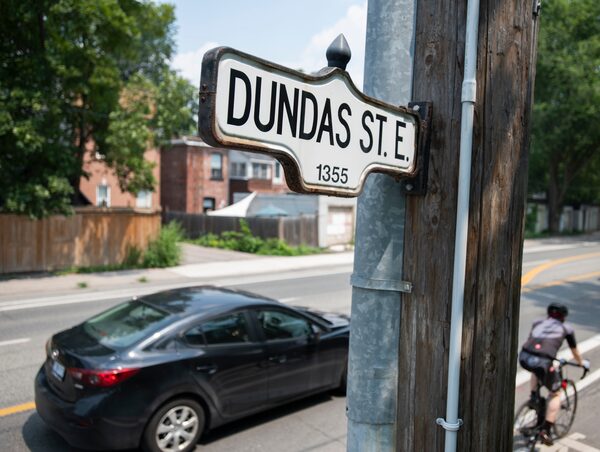
A Dundas St. street sign near Bertmount Ave. in Toronto’s east end on July 6.Fred Lum/The Globe and Mail
Alidad Mafinezam is president of the non-profit organization West Asia Council.
Since Canada enacted immigration reform and opened its doors to the wider world more than half a century ago, millions of people from around the world have chosen to make the country their home. The demographic sea change has been most visible in Canada’s largest cities and regions, especially in the Greater Toronto Area. The GTA is often touted as the world’s most diverse place and ranked this past year as the fastest-growing jurisdiction in the world, with immigrants making up nearly half of Toronto’s residents.
Yet riding along or walking in Toronto’s busiest and most storied districts and neighbourhoods also highlights another fact: The overwhelming majority of names on the streets and institutions, and those adorning the city’s public buildings, museums and monuments, and displayed on the campuses of its universities, colleges and schools, are those of white men.
Street names such as Yonge, Finch, Dundas, Bloor, Dufferin, Bathurst and so many others mostly refer to prominent 19th-century British subjects who settled the land and laid the foundations of the new dominion. In our time, on the exteriors and inside the hallways and main rooms of prestigious venues such as Massey Hall, Roy Thomson Hall, the Art Gallery of Ontario, the Four Seasons Centre for the Performing Arts, the Royal Conservatory of Music, the Royal Ontario Museum and on the campuses of the University of Toronto, Ryerson University and the suburban York University, white names tracing their origins to continental Europe and the British Isles similarly predominate: Jackman, Weston, Koerner, Sharp, Bloomberg, Robarts, Rotman, Dan, Munk, Goldring, Levy, Schulich, Ross, MacDonald, Kerr, O’Keefe, Pittman, Schwartz-Reisman and dozens of others.
While the Michael Lee-Chin Crystal at the Royal Ontario Museum and the building housing the Raymond Chang School of Continuing Education at Ryerson University represent a welcome change for highlighting the generosity, success and contributions of non-European immigrants to Canada, they constitute a tiny minority in a place as diverse and dynamic as Toronto.
When the names on a city’s landmarks don’t reflect the ethnic and cultural makeup and diversity of its population, as is the case in Toronto today, a large part of the citizenry may feel that their backgrounds and contributions of their communities are not reflected in the public consciousness and discourse of Toronto, and more broadly in Canada’s other increasingly diverse cities.
Names often honour wealthy individuals who contribute donations. Their names on public venues confer great prestige on them and their estates, venerating them as exemplary and generous leaders worthy of emulation. Such naming also displays the interplay of belonging and ownership that donors feel toward their city and country. You give back to where you belong and look after what you own. When the names of venues are limited to a select portion of the population, the feelings of belonging and ownership are undermined among others.
To diversify the pool of Canada’s leading philanthropists whose names are put on buildings, immigrant communities and the leading entrepreneurs and business people among their ranks must be made to feel a greater sense of belonging and ownership toward their city, and given responsibility over our collective fate. Fundraising professionals in the city’s leading institutions must spend more time cultivating potential donors among the area’s burgeoning immigrant communities, who possess tremendous reservoirs of monetary and human wealth and goodwill toward their adopted country, but whose involvement and presence in Canada’s philanthropic sector and its arts and letters are well below its potential.
Some names are already being contested in the name of diversity and anti-racism. The reckoning with Canada’s residential-school system this year has coincided with preliminary decisions in the city to change the names of Ryerson University and Dundas Street for the racist attitudes of their namesakes, respectively toward the country’s original Indigenous inhabitants and the enslavement of Black people.
Changing the names of major streets and monuments can be a slippery slope and an arduous, never-ending process, especially when it involves judging 19th-century acts and perspectives with a 21st-century lens. An alternative to “cancel culture” is to ensure that, moving forward, more of our public places and buildings, and the streets that have yet to be built, are named after leading and exemplary individuals who represent Canada’s diversity.
The mission to diversify our social and public arenas, and to place more names of Indigenous and Black people and other people of colour on landmarks, would be especially meaningful if it went beyond celebrating wealthy donors and included highlighting exemplary lives dedicated to service, the arts and education, in addition to the generation of monetary wealth and its dispensing to good causes.
Keep your Opinions sharp and informed. Get the Opinion newsletter. Sign up today.